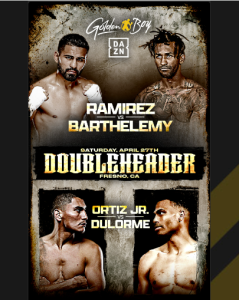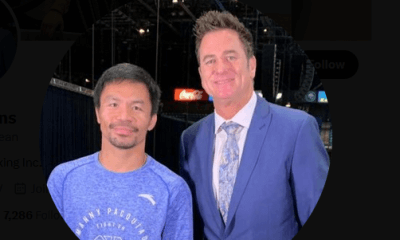Featured Articles
Avila Perspective, Chap. 282: Ryan’s Song, Golden Boy in Fresno and More

Avila Perspective, Chap. 282: Ryan’s Song, Golden Boy in Fresno and More
Don’t call it an upset.
Days after Ryan Garcia proved the experts wrong, those same experts are re-tooling their evaluation processes.
It’s mind-boggling to me that 95 percent thought Garcia had no chance. Hear me out.
First, Garcia and Haney fought six times as amateurs with each winning three. But this time with no head gear and smaller gloves, Garcia had to have at least a 50/50 chance of winning. He is faster and a more powerful puncher.
Facts.
Haney is a wonderful boxer with smooth, almost artistic movements. But history has taught us power and speed like Garcia’s can’t be discounted. Think way back to legendary fighters like Willie Pep and Sandy Sadler. All that excellent defensive skill could not prevent Sadler from beating Pep in three of their four meetings.
Power has always been an equalizer against boxing skill.
Ben Lira, one of the wisest and most experienced trainers in Southern California, always professed knockout power was the greatest equalizer in a fight. “You can be behind for nine rounds and one punch can change the outcome,” he said.
Another weird theory spreading before the fight was that Garcia would quit in the fight. That was a puzzling one. Getting stopped by a perfect body shot is not quitting. And that punch came from Gervonta “Tank” Davis who can really crack.
So how did Garcia do it?
In the opening round Ryan Garcia timed Devin Haney’s jab and countered with a snapping left hook that rattled and wobbled the super lightweight champion. After that, Garcia forced Haney to find another game plan.
Garcia and trainer Derrick James must have worked hours on that move.
I must confess that I first saw Garcia’s ability many years ago when he was around 11 or 12. So I do have an advantage regarding his talent. A few things I noticed even back then were his speed and power. Also, that others resented his talent but respected him. He was the guy with everything: talent and looks.
And that brings resentment.
Recently I saw him and his crew rapping a song on social media. Now he’s got a song. Next thing you know Hollywood will be calling and he’ll be in the movies. It’s happened before with fighters such as Art Aragon, the first Golden Boy in the 50s. He was dating movie stars and getting involved with starlets all over Hollywood.
Is history repeating itself or is Garcia creating a new era for boxing?
Since 2016 people claimed he was just a social media creation. Now, after his win over Devin Haney a former undisputed lightweight champion and the WBC super lightweight titleholder, the boxer from the high desert area of Victorville has become one of the highest paid fighters in the world.
Ryan Garcia has entered a new dimension.
Golden Boy Season
After several down years the Los Angeles-based company Golden Boy Promotions suddenly is cracking the whip in 2024.

Avila
Vergil Ortiz Jr. (20-0, 20 KOs) returns to the ring and faces Puerto Rico’s Thomas Dulorme (26-6-1, 17 KOs) a welterweight gatekeeper who lost to Jaron “Boots” Ennis and Eimantas Stanionis. They meet as super welterweights in the co-main event at Save Mart Arena in Fresno, Calif. on Saturday, April 27. DAZN will stream the Golden Boy Promotions card live.
It’s a quick return to action for Ortiz who is still adjusting to the new weight division. His last fight three months ago ended in less than one round in Las Vegas. It was cut short by an antsy referee and left Ortiz wanting more after more than a year of inactivity in the prize ring.
Ortiz has all the weapons.
Also, Northern California’s Jose Carlos Ramirez (28-1, 18 KOs) meets Cuba’s Rances Barthelemy (30-2-1, 15 KOs) in a welterweight affair set for 12 rounds.
It’s difficult to believe that former super lightweight titlist Ramirez has been written off by fans after only one loss. That was several years ago against Scotland’s Josh Taylor. One loss does not mean the end of a career.
“My goal is to get back on top and to get all those belts back. I still feel like I am one of the best 140-pounders in the division,” said Ramirez who lives in nearby Avenal, Calif.
An added major attraction features Marlen Esparza in a unification rematch against Gabriela “La Chucky” Alaniz for the WBA, WBC, WBO flyweight titles. Their first fight was
a controversial win by Esparza that saw one judge give her nine of 10 rounds in a very close fight. Those Texas judges.
In a match that could steal the show, Oscar Duarte (26-2-1, 21 KOs) faces former world champion Jojo Diaz (33-5-1, 15 KOs) in a lightweight match.
Munguia and Canelo
Don’t sleep on this match.
Its current Golden Boy fighter Jaime Munguia facing former Golden Boy fighter Saul “Canelo” Alvarez in a battle between Mexico’s greatest sluggers next week at the T-Mobile Arena in Las Vegas on May 4.
“I think Jaime Munguia is going to do something special in the ring,” said Oscar De La Hoya, the CEO for Golden Boy.
Tijuana’s Munguia showed up at the Wild Card Boxing gym in Hollywood where a throng of media from Mexico and the US met him.
Munguia looked confident and happy about his opportunity to fight great Canelo.
“It’s a hard fight,” said Munguia. “Truth is, its big for Mexico and not only for Mexicans but for boxing.”
Fights to Watch
Fri. DAZN 6 p.m. Yoeniz Tellez (7-0) vs Joseph Jackson (19-0).
Sat. DAZN 9:30 a.m. Peter McGrail (8-1) vs Marc Leach (18-3-1); Beatriz Ferreira (4-0) vs Yanina Del Carmen 14-3).
Sat. DAZN 5 p.m. Vergil Ortiz (20-0) vs Thomas Dulorme (26-6-1); Jose Carlos Ramirez (28-1) vs Rances Barthelemy (30-2-1); Marlen Esparza (14-1) vs Gabriela Alaniz (14-1).
Photo credit: Cris Esqueda / Golden Boy Promotions
To comment on this story in the Fight Forum CLICK HERE
-

 Featured Articles3 weeks ago
Featured Articles3 weeks agoVito Mielnicki Jr Whitewashes Kamil Gardzielik Before the Home Folks in Newark
-

 Featured Articles4 days ago
Featured Articles4 days agoResults and Recaps from New York Where Taylor Edged Serrano Once Again
-

 Featured Articles1 week ago
Featured Articles1 week agoFrom a Sympathetic Figure to a Pariah: The Travails of Julio Cesar Chavez Jr
-

 Featured Articles3 days ago
Featured Articles3 days agoResults and Recaps from NYC where Hamzah Sheeraz was Spectacular
-

 Featured Articles4 weeks ago
Featured Articles4 weeks agoCatching Up with Clay Moyle Who Talks About His Massive Collection of Boxing Books
-

 Featured Articles1 week ago
Featured Articles1 week agoCatterall vs Eubank Ends Prematurely; Catterall Wins a Technical Decision
-

 Featured Articles4 days ago
Featured Articles4 days agoPhiladelphia Welterweight Gil Turner, a Phenom, Now Rests in an Unmarked Grave
-

 Featured Articles3 weeks ago
Featured Articles3 weeks agoMore Medals for Hawaii’s Patricio Family at the USA Boxing Summer Festival



















